How to make Manhattan-style Fermented Pickles with Garlic and Dill! An easy step-by-step guide to making the most flavorful, crunchy, tangy pickles full of healthy probiotics with only 20 minutes of hands-on time! The pickle brine is like a “tonic” -drink a shot daily to support a healthy gut! Video.
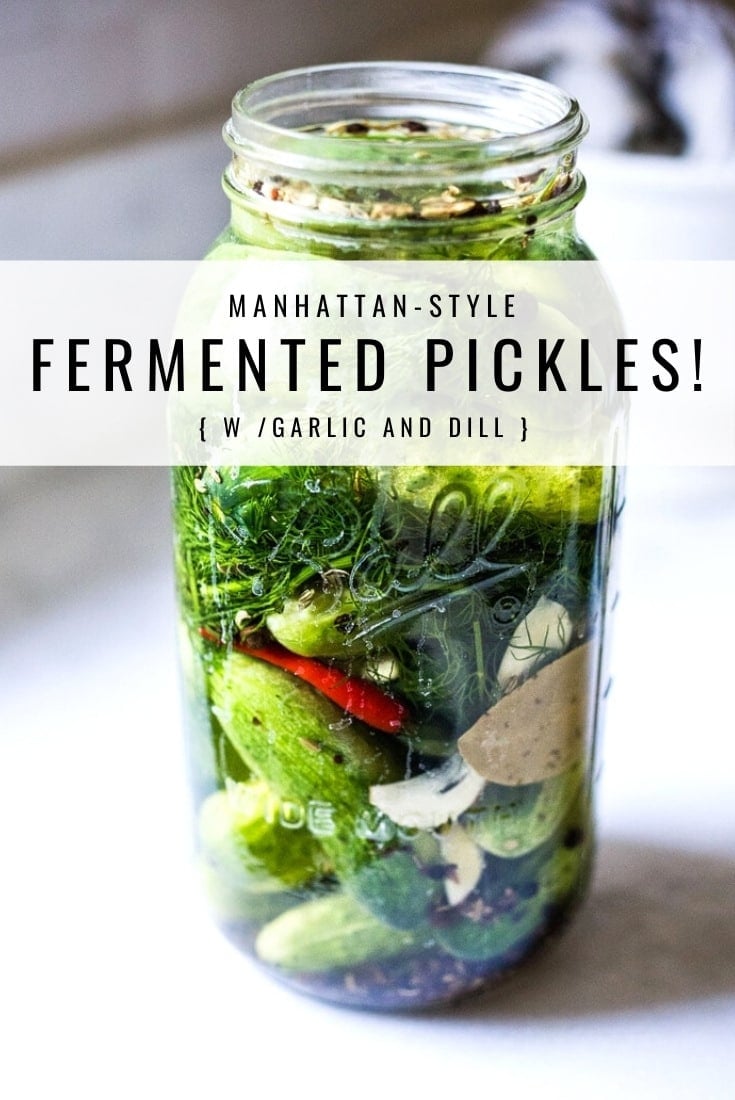
What happens when people open their hearts? They get better. ~Haruki Murakami
I’m excited to share this easy recipe for Fermented Pickles with you! If you are a crunchy pickle lover like me, you will be in heaven. Seriously, these are the best! These Manhattan-style “half-sour” fermented dill pickles are crispy, crunchy, flavorful, and oh-so alive!
Fermented in a salt brine, rather than vinegar, they get their delicious tanginess from light fermentation rather than vinegar.
Full of healthy, gut-healing, immunity-boosting probiotics these little guys are perfect as a low-calorie snack, or sliced and added to sandwiches or served as a tasty side.
Not only are they delicious and incredibly EASY to make, they are also incredibly good for us!
And as crazy as this may sound to some, the fizzy brine itself is like a healing tonic to me – I love to drink a shot of it- especially when I feel like my immunity needs a boost! So flavorful and totally energizing. Or try a Gin and Brine!
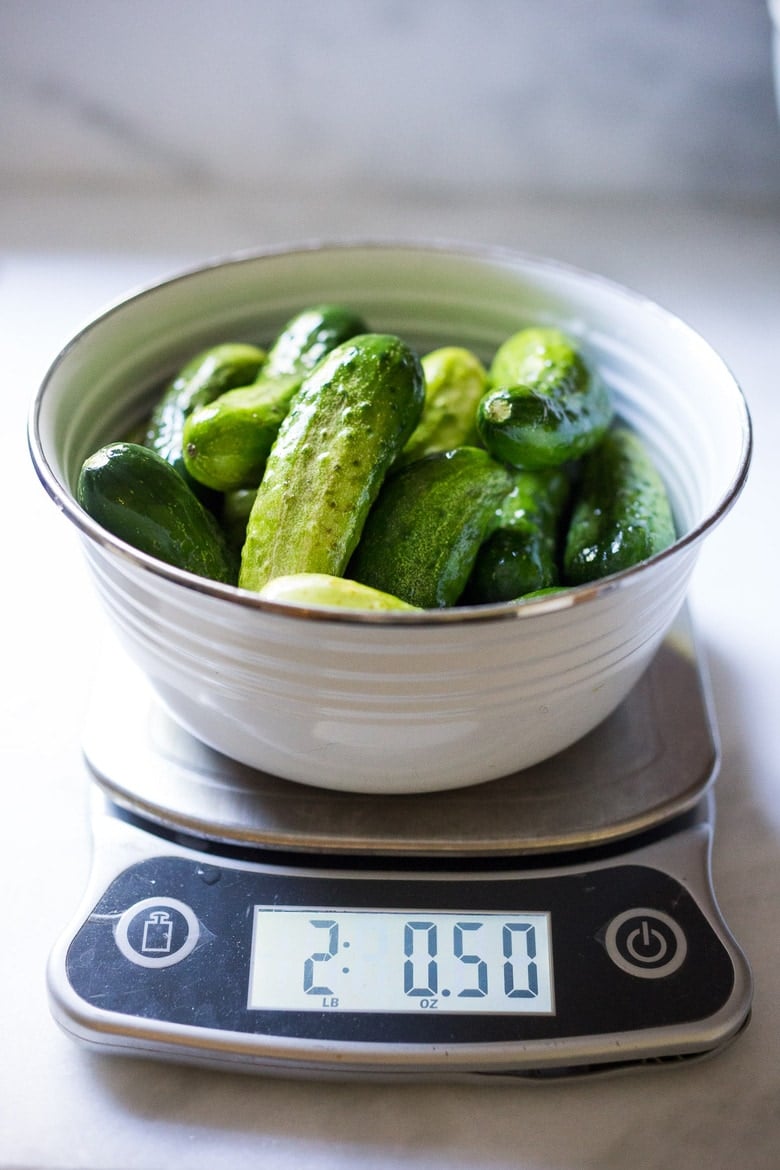
What you’ll need
- Pickling Cucumbers- Small and short (4 inches long) with thin bumpy skin, crisp texture, small seeds, a blocky shape and color gradient from light to dark. Varieties include Kirby, Calypso, Royal, Pickalot, National Picking, Adam Gherkin, Sassy, Eurika, Jackson, Boston Pickling, Northern Pickling… to name a few. You’ll need 2 lbs of “pickling cucumbers.” This recipe makes one large 1/2 gallon jar (or use two quart-sized jars) – a relatively small batch. Pickling cucumbers are most easily found at your local farmers’ market. Ask the farmers if they have “pickling cucumbers” they can help direct you to the right ones. Your pickles will only be as good as your cucumbers, so choose wisely! Make sure they are roughly the same size -about 4 inches long with 1 1/2-inch to 2-inch diameters – so they fit in the jar nicely and ferment at the same rate. I handpicked each one. They should be fresh and crisp with no soft spots.
- Salt-use fine sea salt, or fine Himalayan Pink salt
- Garlic and Onion – we load this up with 10-20 garlic cloves for the best flavor!
- Fresh Dill – use a big handful!
- Spices: Ground Turmeric ( adds fresh flavor) fennel seeds, mustard seeds, whole peppercorns, coriander seeds, whole allspice, dill seeds and celery seeds. Feel free to change or embellish! I added a couple of chilies for a little heat.
- Optional Tannic Acid: Bay leaves, grape leaves, oak leaves, or a couple of slices of fresh horseradish root. Cucumbers contain enzymes that soften them. To prevent this add a few bay leaves or a grape leaf to the jar.
- Two-Quart Mason Jar ( 8 cup mason jar)
- Fermentation weights
- Optional: Air lock, gasket, metal ring
How long does it take to ferment pickles?
These 3% Brined, half-sour crunchy pickles take 3-5 days of fermenting time.
The Brine: SALT TO WATER RATIO
- This recipe is a 3% salt water brine, which is considered “safe”. It equals 7 grams of salt per 1 cup of water. Or, 1 heaping teaspoon salt (1 1/4 teaspoon salt ) per 1 cup of water. This ratio allows one to drink the brine (like a shot) because it is not too salty and is designed for a shorter fermentation period ( 3-5 days). Crunchy, lightly fermented pickles!
- If you want a stronger brine for a longer ferment, feel free to go up to 4.5%. So for example, 3.5% Ratio= 9 grams of salt per 1 cup of water, 4.5% brine =10.8 grams of salt per 1 cup of water. For a 4.5% brine, half-sour pickles take 5-7 days, full sour pickles 14-21 days.
Fermented Pickles (step-by-step Instructions)
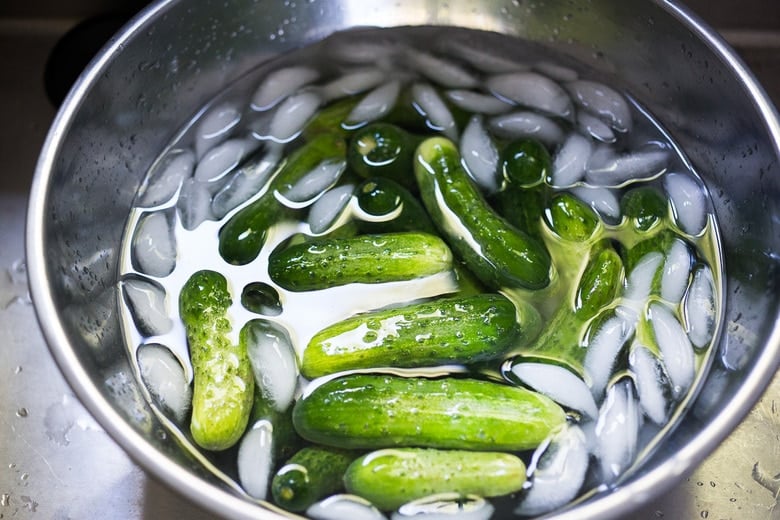
Step 1: Wash the cucumbers, slice off 1/16 inch of the blossom end, and soak them in an ice bath for 15-30 minutes to firm and crisp them up. There are enzymes in the blossom end that can make your pickles soft, so be sure to remove them.
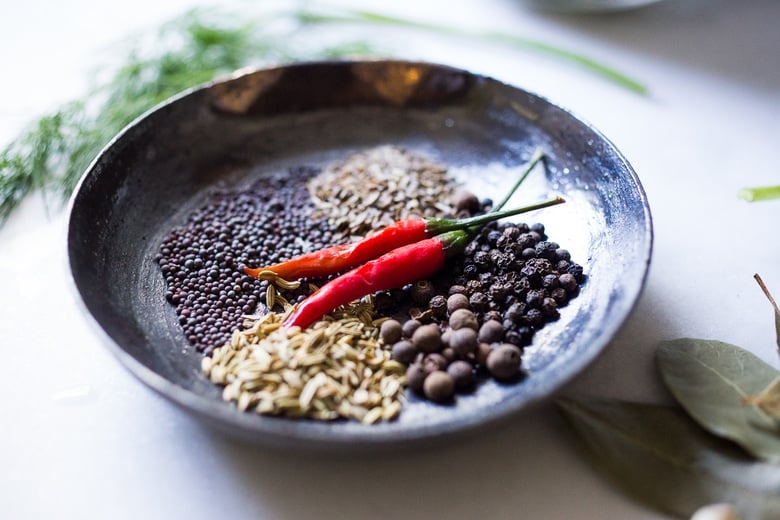
Step 2: Slice the garlic lengthwise and gather your spices.
Because these fermented pickles are left whole, you want the brine to be extra flavorful. I add a lot of garlic… 10-15 cloves, sometimes 20! Fermented Garlic is really good for the gut too!
Step 3: Place the spices on the bottom of the jar, then sliced garlic, fresh dill and bay leaves, and then add 2 layers of cucumbers, end on end, in a large two-quart jar (half-gallon). Press everything down.
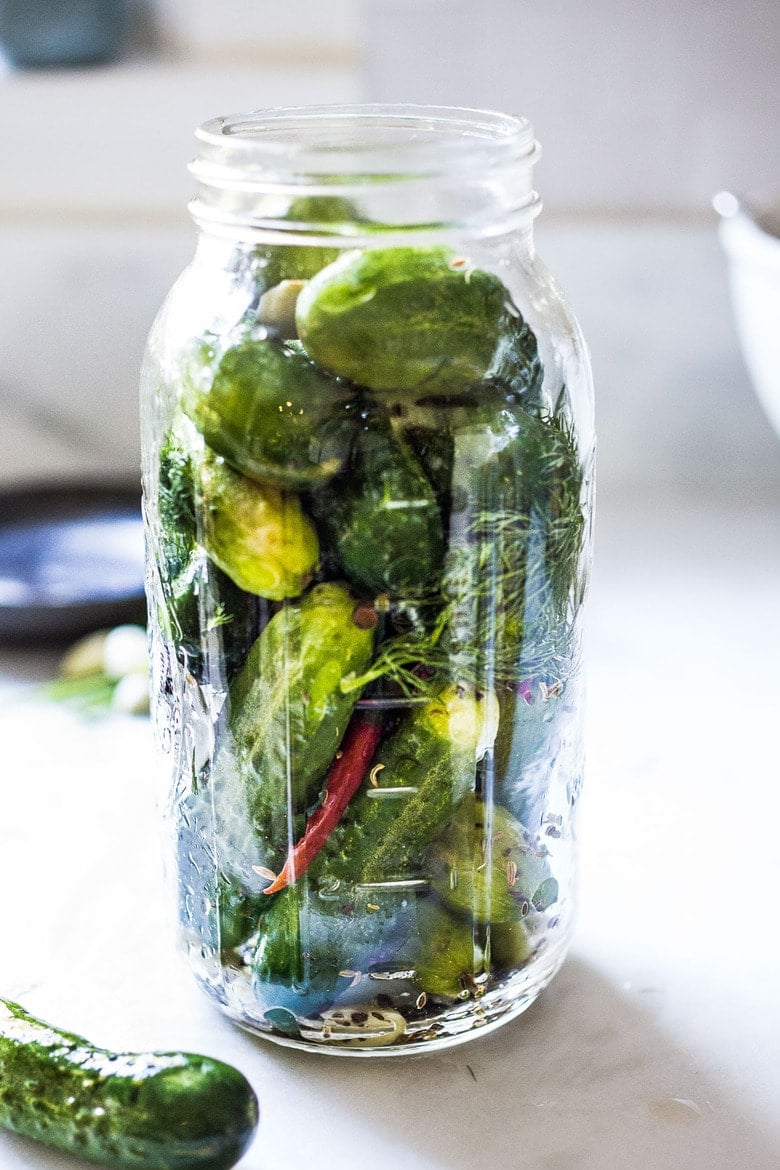
Step 4: Carefully measure and mix salt and water to create the 3% salt water brine- then pour this brine over the pickles leaving 1 1/2 inches of headroom.
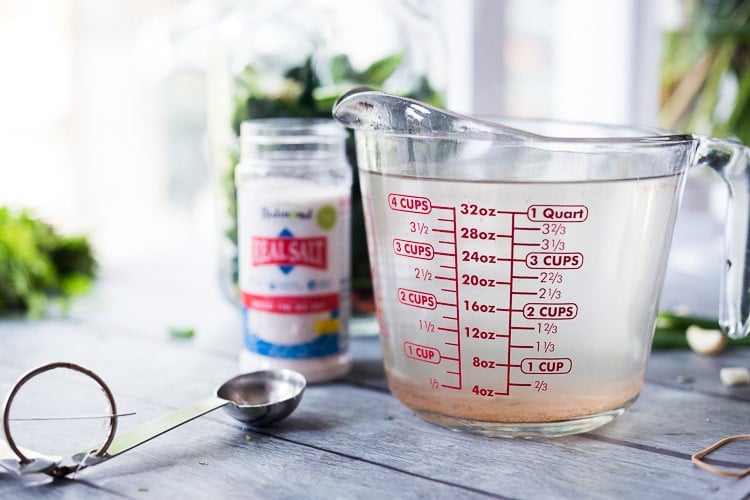
How salt works in fermentation:
- In a nutshell, using the right ratio of salt in fermentation encourages the growth of healthy bacteria while at the same time killing off bad bacteria. You want to be precise when measuring the salt and water in these kinds of recipes.
- Too much salt may kill off ALL of the bacteria -preventing fermentation.
- Too little salt will allow bad bacteria to keep on living. It is a fine balance. 😉
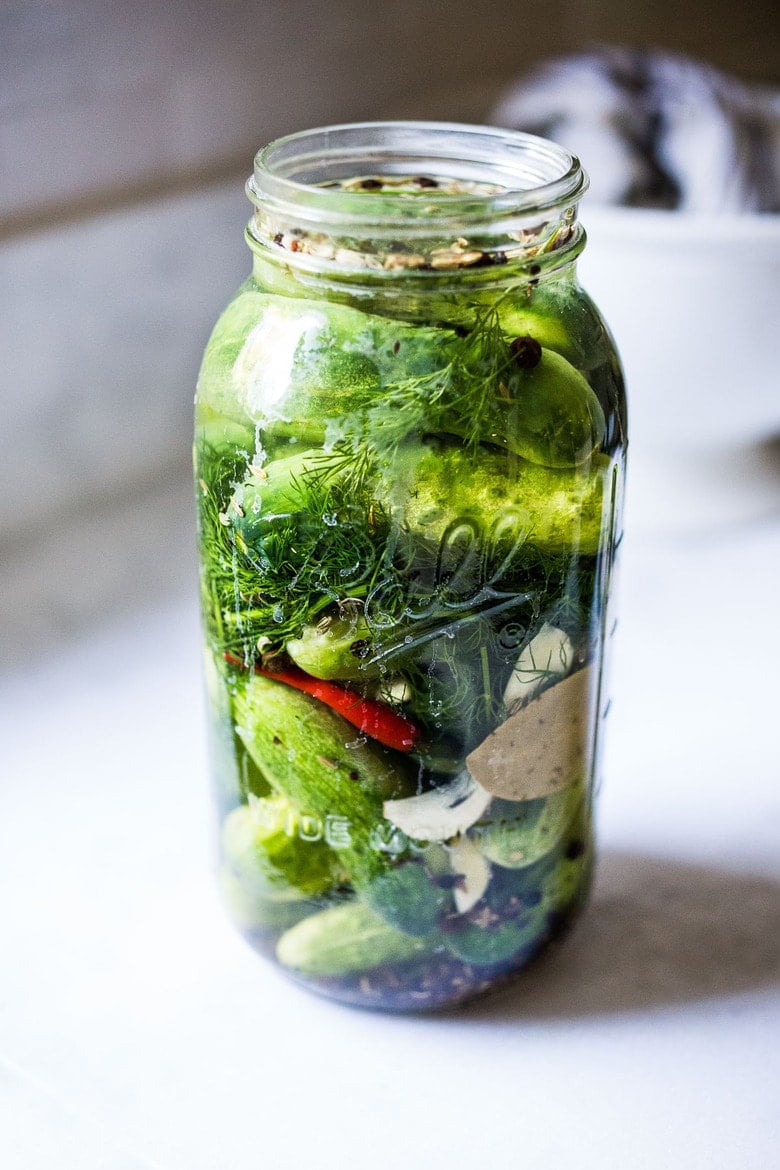
Step 5: Weigh down the cucumbers so they are completely submerged under the liquid, using a couple of fermentation weights, or a small zip lock bag filled with a little water (in a pinch).
MOLD: If the cucumbers or seeds are not submerged under the brine and become exposed to air- they can develop mold, so spoon any floaters out with a slotted spoon. Most seeds should stay submerged.
Step 6: Cover loosely with a lid or towel (to prevent bugs or flies from coming in, and to allow gases to escape) place in a bowl or pan to catch any overflow, and place in a cool dark place for 3-7 days, like the basement. You can also use and airlock lid- which allows air to escape, but nothing to fly in.
Step 7: Check after 2-3 days. Look for signs of life: bubbles/ or cloudy water. A cloudy brine is GOOD. Tap the jar and see if bubbles rise to the top. Check to see if any brine overflowed into the bowl ( both signs of life). This often takes about 3-5 days, I find 4 days is the “sweet spot”, depending on temperature. Cloudy brine is delicious and nutritious!
Step 8: Place the jar in the fridge to further slow the fermentation with a loose lid. They will continue to ferment very slowly and will keep indefinitely.
Expert Tips:
- Ferment at cooler temps (60-70F) to keep pickles crisp. If your home is hot, try placing in a cooler with ice. Take the temp of the brine.
- The longer you ferment them (unrefrigerated), the tangier they will get. But they will also get softer. I like them crisp, but you may want them tangier and softer. You can taste them at any point after you see bubbles.
- Smell: your ferment should smell tangy, garlic and fresh. If you notice anything foul or unpleasant, your ferment may have been contaminated: most commonly by dirty hands, dirty utensils, or a dirty jar.
- If you want to create a “fizzy” brine for drinking, tighten the lid, and burp daily if leaving out. You can tighten the lid in the fridge, but burp weekly. This will create a little pressure and give it some effervescence.
- Anything that touches air- may mold. Always fish out any floating spices with a slotted spoon to prevent this.
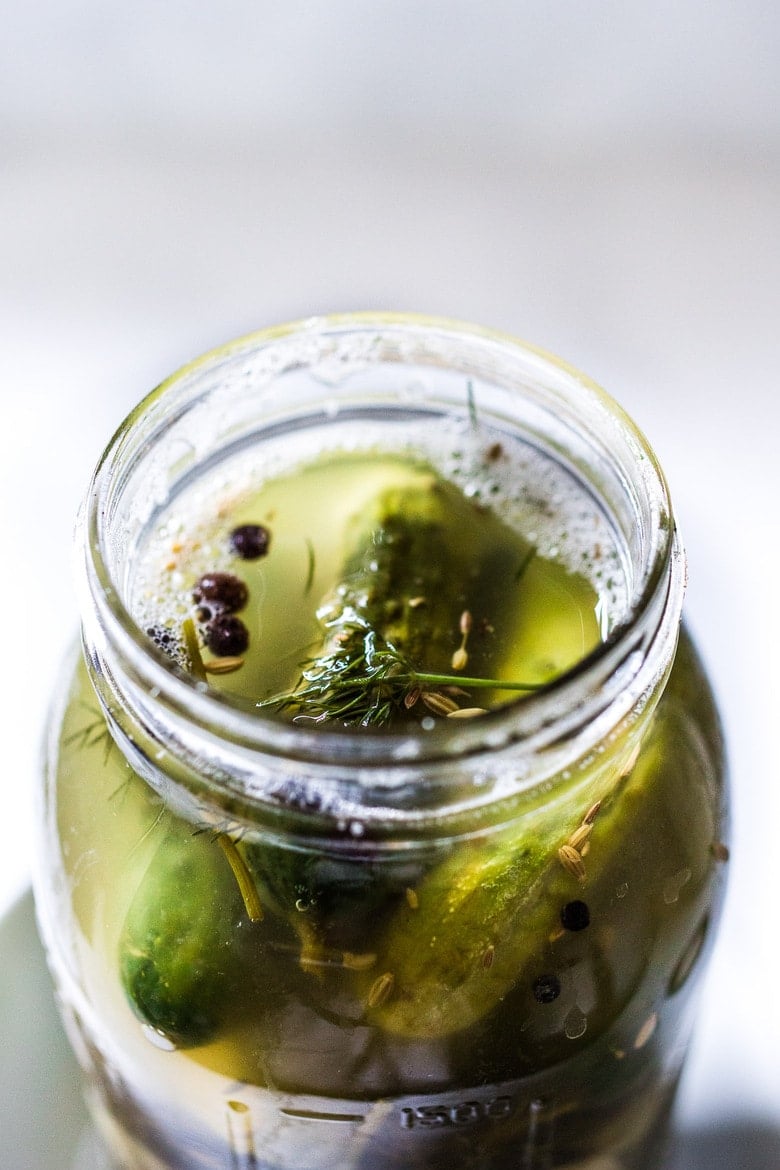
Once they are cold, give them a taste. They should be crunchy and flavorful! The brine is deliciously tangy, salty, and effervescent -so tasty and full of gut-supporting probiotics. The garlic is tasty too! Eat it!
I find myself often drinking shots of the brine! I also make this Gin & Brine Martini!
Let me know how you like this one in the comments below!
xoxoxo
More Favorite Ferments!
- Curtido & Cultured Salvadoran Slaw
- How to make Sauerkraut (Simple Cultured Cabbage)
- Beet and Cabbage Sauerkraut
- Cucumber Kimchi Pickles
- Turmeric Sauerkraut
More from Feasting at Home
How to make Fermented Pickles| 45-sec video
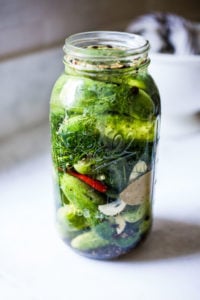
Homemade Pickles with Garlic and Dill
- Prep Time: 4 days
- Total Time: 4 days
- Yield: ½ gallon
- Category: fermented, preserved
- Method: fermented
- Cuisine: American
- Diet: Vegan
Description
How to make Manhattan-style, fermented Dill Pickles! A simple recipe for making the most flavorful, crunchy, tangy, garlic dill pickles with only 15 minutes of hands-on time. Full of healthy, gut-healing probiotics these little guys are perfect as a low-calorie snack, or sliced and added to sandwiches.
Ingredients
- 2- 2 1/2 lbs pickling cucumbers– all similar size ( 5 inches)
- 5 cups filtered water or tap water (that is not overly chlorinated)
- 2 tablespoons fine sea salt or Himalayan salt — or basically one heaping teaspoon fine sea salt (7 grams) per one cup of water, for a 3% brine (see notes)
- 1/4 teaspoon turmeric (optional, adds a “fresh” flavor)
- 1 teaspoon each: fennel seeds, coriander seeds, allspice, peppercorns, dill seeds, mustard seeds, celery seeds- and feel free to add more peppercorns!
- 10-20 garlic cloves, sliced (or double for extra garlicky)
- 1/2 onion, thinly sliced (optional)
- big handful of fresh dill
- 1-3 fresh red chilies – or dried arbol chilies, or add chili flakes (all optional)
- 3-4 bay leaves (or a grape leaf or oakleaf) – these are sources of tannic acid to help them stay crisp.
Instructions
- Prep Cucumbers: Rinse the cucumbers, remove 1/16-inch of the flower end of each cucumber (keeps them from getting soft) and place them in an ice-water bath, to crisp them up (15-30 minutes). Leave them whole.
- Make the brine: Mix salt (2 tablespoons) and 5 cups cold water until dissolved.
- Wash your hands, jar and any utensils. No need to sterilize, just clean!
- Assemble: In a large, clean two-quart mason jar, place all the whole spices into the bottom. Add the dill, garlic and onions or turmeric if using. With clean hands, pack one layer of cucumbers tightly, standing on end, then add the bay leaves, then add the second layer of cucumbers standing on end.
- Press everything down, leaving 1 ½ inches of headroom. Pour the salt water brine over the top and weigh down the cucumbers with fermentation weights so they are submerged under the brine. Remove any spices that may have floated to the surface (which can mold).
- Cover the jar loosely with a lid or with a cloth- basically, the pickles will bubble and you want air to be able to escape.
- Place the jar in a pan or bowl to collect any overflow and leave it in a cool dark place (60-70F) for 2 -3 days (a basement, or lower kitchen cupboard) and check for bubbles or overflow, indicating fermentation. Half sour pickles will take 3-5 days with crisp, white interiors. If is colder than 65F, it may take longer, if hotter, they will ferment faster. Full sour pickles will take 14-21 days (see notes for a stronger saltwater ratio).
- After 2 days, check for signs of life: bubbles, overflow, or clouding. Tap the jar, and see if tiny bubbles rise to the top. I usually ferment for 3-5 days. Longer ferments will yield tangier pickles but will get softer as they ferment, and lose their vibrant color. Up to you. You can taste them at any point after you see bubbles, and ferment longer if you like. The brine will get cloudy as it ferments- this is a good sign! Once you see active bubbles, you can at this point place the jar in the fridge, where it will continue to ferment, but much more slowly. Keep the pickles submerged.
- Once chilled, give them taste. They should be crispy and flavorful with a little tang. (At this point, if you want a tangier or softer pickle, you can absolutely pull them back out again and ferment for a few more days longer if you want.)
- If you like fizzy brine, tighten the lid, burping every week or so or try using an airlock. If you don’t want to think about it, give the lid one loose twist, so it’s on there, but gases can escape.
Notes
If you need more brine, make sure you use the same ratio- 1 heaping teaspoon sea salt per one cup of water.
If using a grape leaf, place it on the side of the jar, then layer the remaining ingredients.
If pickles turn out too soft- it may be due to too warm of temperature during fermentation, or the flower end wasn’t removed (the flower end of the cucumber has enzymes that can soften pickles).
Feel free to use 2, quart-size jars, dividing cucumbers, spices and brine between the jars.
BRINE: This recipe is a 3% salt water brine, which is considered “safe”. It equals 7 grams of salt per one cup of water. I’ve had really good luck with this ratio – and this ratio allows me to drink the brine (like a shot) this is really healthy – full of good gut-supporting bacteria!
If you want a stronger, saltier brine, feel free to go up to 4.5%. For a full sour pickle (14-21 days) use a 4.5% brine.
- 3% ratio = 7 grams salt per 1 cup of water. (1 1/4 teaspoon fine sea salt, per 1 cup water)
- 3.5% Ratio= 9 grams of salt per 1 cup of water. (1 1/2 teaspoon fine sea salt, per 1 cup water)
- 4.5% ratio 10.8 grams of salt per 1 cup of water. (2 teaspoons per cup of water)
Cutting the Cucumbers: I recommend leaving them whole. The texture is much better. After your first successful batch, feel free to experiment.
Nutrition
- Serving Size:
- Calories: 16
- Sugar: 1.3 g
- Sodium: 297.4 mg
- Fat: 0.2 g
- Saturated Fat: 0 g
- Carbohydrates: 3.7 g
- Fiber: 0.5 g
- Protein: 0.7 g
- Cholesterol: 0 mg
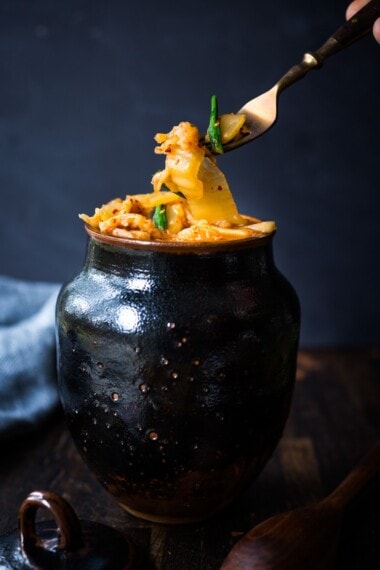
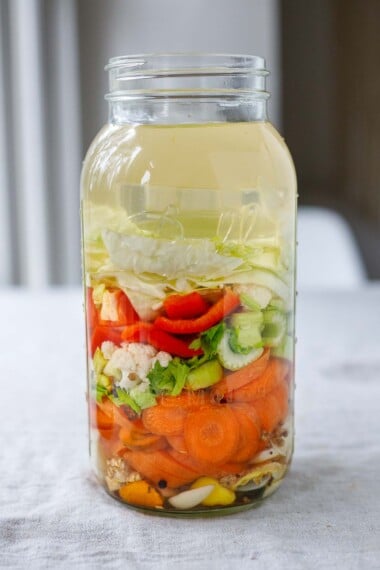
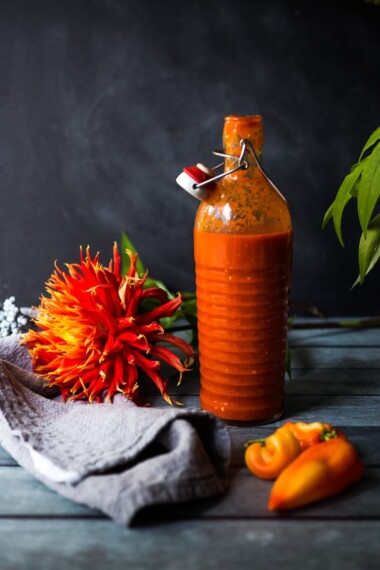
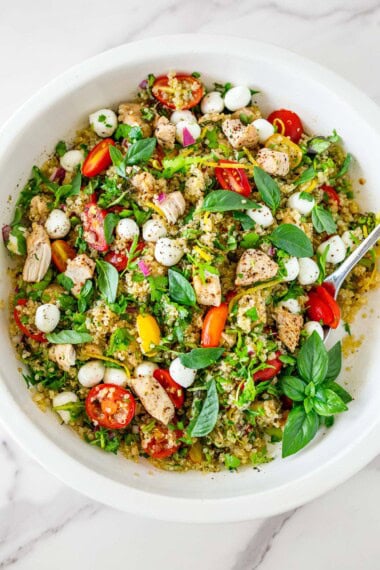
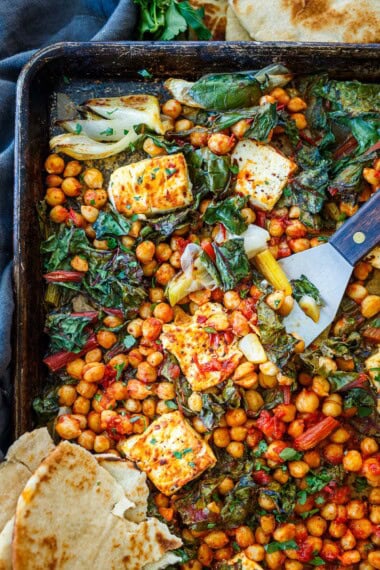
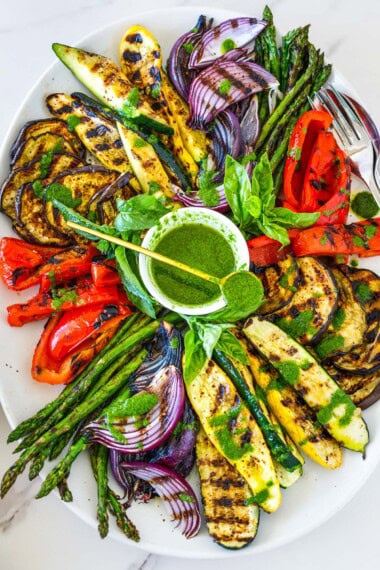



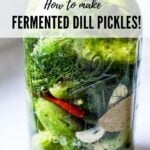
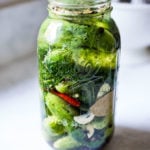
Hi, I made the pickles and today is day 4. I’m refrigerating them today. I had a small piece but it didn’t taste like pickled pickles at all. Did I do something wrong or do they need more time outside the refrigerator? Please help.
How did they taste? Did you see any bubbles?
Hi I am just checking….we are supposed to dissolve all 3 tablespoons of salt into only 1 cup of the water? Then we pour the other 5 cups after? Can I just dissolve the salt into 6 cups and pour over?
yes, you can- I just like to heat up the one cup a bit first so salt dissolves quicker but either way will work.
Hi Sylvia,
I just finished the fermentation process, and tried the first one. I must admit, it was more bitter/sour than I was expecting. I was able to finish the pickle, but I would not describe it as tasty, or delicious at all. This is my first attempt to make/try fermented pickles. Do you think that I potentially messed something up? Or perhaps, are they normally such that you have to grimace to swallow?
Thanks for your help, I really wanted these to taste good!
Thanks,
Joe
I wonder if it was your cucumbers? What kind did you use and did you try before pickling?
Thank you for the response. I used some “organic mini cucumbers” that I bought from the local HEB grocery store. They were about 4 or 5 inches long. I did taste one prior to fermenting and it tasted like I would expect a cucumber would. Do I need to find an actual farmers market to get the right cucumbers? Sorry my naivety is showing haha
That is so strange. You know, I’ve done this recipe with those small cucumbers too, but sliced them first. They were not bitter. I’m not sure what could have made your bitter. Are there any bubbles or is the brine tangy or sour at all? Just trying to tell if it started fermenting. Those pickling cucumbers yes are usually found at farmers markets. They have a thicker skin.
Sylvia, this was easy , fast and I love it. thank you
Hi! I am on day 4.. 1 made 4 jars.. i jar is just starting to get cloudy but no bubbles… ??
Tap the jar and see if any little bubbles rise up. Cloudy is good. Are you somewhere colder?
Wouldn’t 3.5 tablespoons of salt make more sense? This gives you about a 3.5% brine, correct? Wouldn’t 2 tablespoons be too low for 6 cups of water?
Yes Jim. Something is wrong with my brain. I messed up my calculation. I like it 1 1/2 teaspoons per cup of water. Or 3 tablespoons. I’m sure 3 1/2 is great too. Sorry.
No problem! I was confused because it looked like you changed it to 2 tablespoons based on a review below, however I was trying to figure out the calculations for a 3.5-5% brine and it was confusing me :-).
Yes I see why. I did the calculation again after that, but did it wrong, then changed it. I’m so glad you said something. I changed it back, it was right after all, and removed the confusing comments. Hopefully clearer now. 🙂
Ha no worries! Glad I could help. These pickles are definitely NOT too salty.
I noticed you change the salt ratio due to a typo in the recipe. It now says 2 tablespoons. What was it before? Because I made this recipe late last year and it tasted totally fine. Did it used to call for 3 tablespoons of salt?
Yes, I messed it up. I fixed it now.
I just made a batch of these. Is it ok for some seeds and herbs to be floating on top of brine while fermentation happens? Excited to try them when they are ready! Thanks for sharing the recipe.
YES, TOTALLY OK. 🙂
This is my first time making pickles! This recipe was easy to follow. It turned out well. I saw bubbles forming after 3-4 days, then in the fridge they went. Had some tonight with dinner. Yummy. Garlic dill flavor is strong. Cukes were crisp! Great way to extend the life of last weeks pickles! Will share with friends. Btw: I just used any kind of cukes , because I had a variety of them from my csa boxes., and they still came out! So go ahead and try this recipe. If u don’t like a spice, don’t use it. Don’t have it, maybe sub in a spice that is similar. Just saying, give it a go.
Im so glad you gave this a try! I actually use this recipe to ferment everything! Carrots, cauliflower, peppers or whatever scraps I need to use up. The brine is delicious- I guzzle it!
This is my first ever ferment. I’m wondering how long to leave it ferment in the fridge before I can eat it? Or is it ready to go after the first 3-7 days?
Hi Amy, You can eat them at any point, yes they are ready to go, but I find waiting a few more days develops the flavors further. Like a week.
Great recipe! So when I eat all my pickles, can I add more cucumbers to the brine?
Yes, or you can drink the brine like I do…delicious!
did you slice off the tips of the cucumbers,, helps to keep them for storage,,,also 15 grape leaves and 6/7 bay leaves per gallon of 3/4 inch cukes will keep them very crisp for at least one year…in 2 qt. jars refrigerated,, we usually make 10 gallons per year in old red wing crocks but they never last
If I cant find the pickling cucumbers which do you suggest?
They are much easier to find in the summer. I haven’t tried this with other cucumbers…but pickling cucumbers have the perfect thickness of skin. I hesitate to recommend another kind.
Just finished preparing this one. How long do you suggest fermenting the pickles once they move to the fridge?
I just keep them in there until they are gone! They are stored in the fridge indefinitely.
How long did you leave them in the fridge before you started eating???
Just a few days. like 3!
Thank you for this wonderful receipe. Can I use it to pickle different vegetables like fennels, peppers, carrots ? Thanks for your reply
Yes I think it would work fine!
How many bay leaves?
I’m so sorry! 3-4! Updated the recipe.
I love to ferment, was wondering what temperature would a cool, dark place be?
Hi Terry! 50-60 F. Basically, cooler temps slow the fermentation down a bit. It’s OK to ferment at room temp (like 70 F) but it will ferment faster. Which is ok. I’ve heard a slower ferment yields better flavor, but honestly not sure if true?? Just don’t put it by your stove, and I think it will be fine! Perhaps use lower cabinet in the kitchen, if no basement. 🙂
Is it necessary to cut off the blossom end of the cucumbers before brining? That is always a needed step when making traditional pickles with a vinegar brine.
I’ve heard that as well and actually tried it both ways, and found no difference. But up to you?
Recipe works great, and the pickles are terrific!
Just tried our first batch last night. So delicious! Just like the refrigerated kind we buy at the grocery store- only better because we made these ourselves. Thanks for sharing this fabulous recipe!
Success! We love them!
Yay!!! So happy you like them…I LOOOOOVE them! Such a tasty healthy snack.
How long would these last in the fridge?
Indefinitely!
How do you make this with sliced cucumbers? I’m innudated with cucumbers this year, but they are larger….6″ long. Would love to use with this recipe.
What if you tried spears?
How can I be sure the cucumbers do not produce harmful toxins while in the fermentation process?
What keeps them safe to eat?
I really enjoy your posts. Great recipes and photos
Salt kills the bad bacteria. I guess it requires a bit of faith. ?
“A couple notes on the brine: You want to use the exact ratio of salt to water in the recipe. Too much salt may kill off all of the bacteria -preventing fermentation. So be sure to measure”. This is what I read on your instructions, then on the recipe it says 3 1n3 1/2 TBSP dea salt and 6 cups of water. Please clarify.
Yes. Use 3 1/2 tablespoons of salt, mixed with 6 cups of water. I’m not sure I understand your question? I’m sorry!
I was wondering what size salt grain for the brine, since that will affect how much salt is in the teaspoon measure. Do you have a weight in grams?
Hi Sherri- I use a fine grain of salt.
I read the recipe the same way – you don’t mean use equal parts salt to water but exact measurements as the recipe states. I’ve fermented pickles in the past so already had my ingredients but needed the salt to water ratio. Luckily I read the whole page or I’d have incredibly salty pickles 😊
OH! I see the confusion! OK- I fixed it. 3 1/2 tablespoons sea salt to 6 cups water. Thanks!!!